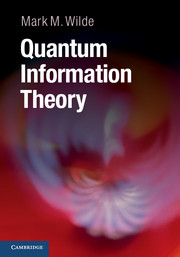Book contents
- Frontmatter
- Contents
- How To Use This Book
- Acknowledgments
- Part I Introduction
- Part II The Quantum Theory
- Part III Unit Quantum Protocols
- Part IV Tools of Quantum Shannon Theory
- Part V Noiseless Quantum Shannon Theory
- Part VI Noisy Quantum Shannon Theory
- 19 Classical Communication
- 20 Entanglement-Assisted Classical Communication
- 21 Coherent Communication with Noisy Resources
- 22 Private Classical Communication
- 23 Quantum Communication
- 24 Trading Resources for Communication
- 25 Summary and Outlook
- Appendix A Miscellaneous Mathematics
- Appendix B Monotonicity of Quantum Relative Entropy
- References
- Index
22 - Private Classical Communication
from Part VI - Noisy Quantum Shannon Theory
Published online by Cambridge University Press: 05 May 2013
- Frontmatter
- Contents
- How To Use This Book
- Acknowledgments
- Part I Introduction
- Part II The Quantum Theory
- Part III Unit Quantum Protocols
- Part IV Tools of Quantum Shannon Theory
- Part V Noiseless Quantum Shannon Theory
- Part VI Noisy Quantum Shannon Theory
- 19 Classical Communication
- 20 Entanglement-Assisted Classical Communication
- 21 Coherent Communication with Noisy Resources
- 22 Private Classical Communication
- 23 Quantum Communication
- 24 Trading Resources for Communication
- 25 Summary and Outlook
- Appendix A Miscellaneous Mathematics
- Appendix B Monotonicity of Quantum Relative Entropy
- References
- Index
Summary
We have now seen in Chapters 19–21 how Alice can communicate classical or quantum information to Bob, perhaps even with the help of shared entanglement. One might argue that these communication tasks are the most fundamental tasks in quantum Shannon theory, given that they have furthered our understanding of the nature of information transmission over quantum channels. Though, when discussing the communication of classical information, we made no stipulation as to whether this classical information should be public, so that any third party might have partial or full access to it, or private, so that any third party does not have access.
This chapter introduces the private classical capacity theorem, which gives the maximum rate at which Alice can communicate classical information privately to Bob without anyone else in the universe knowing what she sent to him. The information-processing task corresponding to this theorem was one of the earliest studied in quantum information theory, with the Bennett–Brassard-84 quantum key distribution protocol being the first proposed protocol for exploiting quantum mechanics to establish a shared secret key between two parties. The private classical capacity theorem is important for quantum key distribution because it establishes the maximum rate at which two parties can generate a shared secret key.
- Type
- Chapter
- Information
- Quantum Information Theory , pp. 532 - 549Publisher: Cambridge University PressPrint publication year: 2013

